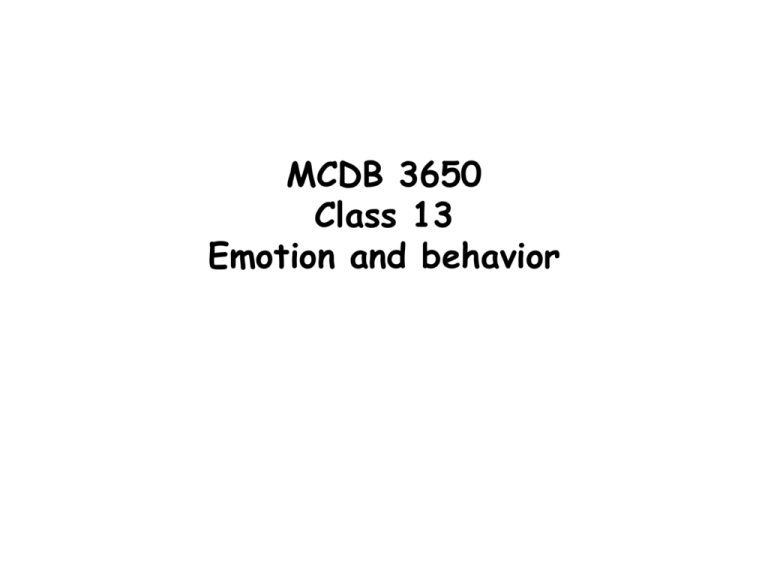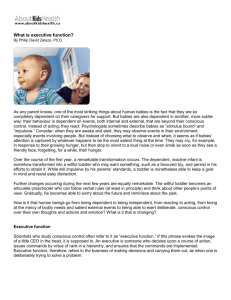MCDB 3650 Class 13 Emotion and behavior
advertisement

MCDB 3650 Class 13 Emotion and behavior Good-based model of Choice: value ascribed in the orbitofrontal cortex; action (attention, motor output, etc) follows the value Humans with orbitofrontal lesions often have eating disorders, risk-seeking, gambling, and abnormal social behavior Suggest we need individual neurons in the OFC to encode value, to make “rational” choices • When we make a choice, if we “think too much”, then we don’t like choice that was made • If asked to explain why choosing something, also are later unhappy with choice “fast” part of our brain (not the prefrontal cortex) picks unconsciously “slow” part of our brain (prefrontal cortex) weighs options, chooses consciously If distracted, prefrontal cortex can be inhibited i.e., I choose cake if I’m trying to hold something else in my mind, but an apple if not distracted Interes'ng reading Thinking Fast and Slow, by Daniel Kahneman Questions of Morality On Radiolab, several questions about morality were posed to people. Most people were aligned on their answers suggesting that morality is a fundamental construct of the human condition Some questions seemed easy Some were harder. What made them harder ? What “got in the way” of making a quick decision? Making Moral Decisions • When we are making these tough moral decisions, different parts of are brain are ‘battling’ it out – the more developed part of the brain (prefrontal cortex) uses logic—weighs consequences of loss of life – the more animalistic part of the brain (limbic system) says no, (don’t kill your baby, don’t push a person)—”gut reaction” “triune brain” reptilian brain limbic system neocortex Emotion Physiological emotion: the autonomic nervous system Increased heart rate Increased blood flow/sweating Visceral reaction (gastrointestinal response) vs. Feeling emotion (subjective) Conscious awareness of the emotion Papez circuit (early 1900s) Removal of cortex with preservation of posterior hypothalamus: “Sham rage” “preprogrammed” rage pathway? Physiological emotion Reticular formation: cardiovascular function, respiration, swallowing, sleep/wake brain state, and other widespread visceral motor and somatic motor responses) Hypothalamus: coordinator of emotional behavior: input to the reticular formation Output to the Autonomic nervous system (smooth muscle, glands) Sympathetic N.S. Sympathetic: speeds up heart rate (Norepinephrine): physiological component of emotional response Parasympathetic (e.g. digestion, decrease heart rate): neurons in brainstem, long projections to target muscles, uses Acetylcholine Physiological responses happen in response to input BEFORE you are consciously aware of stimuli but, injections of Norepinephrine, which stimulate the sympathetic NS, can produce a variety of behaviors/emotions depending on context. So, emotion results only partly from the physiological response Conscious component: feelings The limbic system Orbitofrontal and medial prefrontal cortex, basal ganglia, thalamus, amygdala Remove medial temporal lobe (includes good chunk of the limbic system) in monkeys Hyperactivity, hypersexuality, but no excitement anger or fear The cornerstone of the limbic system is the amygdala Emotional experience: feelings The amygdala links Prefrontal cortical regions that process sensory information (awareness) with hypothalamus and brain stem effector systems (expression of emotional behavior) and memory (hippocampus) Areas of the brain involved in emo2onal responses and reward responses are linked to decision making behavior (nucleus accumbens, VTA, substan' nigraa) The amygdala is involved in association of auditory and aversive stimuli: conditioned fear response in rats (sound) Consciousness (pain) Reticular formation automatic freezing behavior Cut “1”: still elicit freezing behavior Cut “3”; no freezing behavior Hypothalamus (blood pressure) Amygdala can produce a response without involvement of the cortex Fear and the amygdala in humans Amygdala lesion I’m handing out three different sets of data about emotional processing Please explore the data, draw some conclusions, and be ready to tell the rest of the class about it Emo'onal influences on percep'on ADen'on and emo'on Emo'onal Regula'on What happens when emotional regulation goes awry? People with an absence of emotionà more violent? Or is it an excess of emotion? Different kind of emotion? Morality? Frontal Lobe • The frontal lobe communicates with the emotional brain(amygdala and hypothalamus) • Thus, thought to be involved in helping people make “good” decisions in emotionally charged situations Impulse murderers have lower levels of metabolic activity in the frontal cortex, while criminals who have committed premeditated murder have normal frontal cortex activity Differences in emotional processing: lack of control from frontal cortex? 16 apprehended offenders (“unsuccessful psychopaths”) 13 “successful psychopaths” (not caught) “Unsuccessful” subjects had 22.3 percent lower gray matter in prefrontal cortex among (when compared to controls) imbalance in left vs right hippocampus decreased frontal lobe activity “Successful” criminals were normal in these areas Some correlations in repetitively violent people • Lower activity in frontal cortex • Low resting heart rate • Lack of fear, or indifference in childhood – Suggesting problems in the amygdalamirror neuron connections (on the other hand, extreme shyness can translate into depression in adulthood) Other factors: neurotransmitter levels? Fluctuation in serotonin may be important: -- levels are low in animals when they are threatened -- high in animals with dominant status Serotonin inhibits secretion of stomach acid and stimulates smooth muscle (physiological responses) but also acts in many sites throughout the brain, on many different serotonin receptors Is there a connection between violence and serotonin levels? People with depression have lower levels of serotonin --Serotonin levels are measured by concentration of 5hydroxyindoleacetic acid (5-HIAA) in cerebrospinal fluid (produced when serotonin is broken down by monoamine oxidase, MAO) -- Thus, low levels of serotonin could be shortage of serotonin or lack of MAO (in which case serotonin levels might actually be high) Women generally have lower levels of serotonin; men have higher levels Clinically depressed individuals have higher blood flow in amygdala, orbitofrontal cortex Other interesting things to consider: Left and Right hemisphere Damage to posterior frontal and anterior parietal lobes on right side Ø Loss of expression of emotion But not the person s subjective feeling of the emotion (a lesion in the same place on the left side leads to Broca s aphasia!) • Left hemisphere: positive emotions • Right hemisphere: negative emotions • Incidence of depression in patients with lesions of the left hemisphere is much higher than in patients with lesions of right hemisphere (lesions in right hemisphere lead to cheeriness !) General differences in activity between men and women Left amygdala active when women feel disturbed Right amygdala active when men feel disturbed











